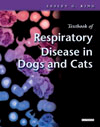|
|
|
| |
 |
|
|

|
 推薦指數:
推薦指數:





|
|
- 內容介紹
|
Textbook of Respiratory Disease in Dogs and Cats
By Lesley G. King, MRCVS, MVB
Approx. 688 pages, Over 245 ills, Copyright 2004
Description
This textbook is a clinical resource for the management of dogs and cats with respiratory tract disease. The only book of its kind on the subject, it is an essential resource for students and clinicians specializing in this area of treatment of dogs and cats. Main sections cover approaches to problems, diagnosis, pulmonary function testing, non-specific management of disease, and specific disorders of the respiratory tract.
Key Features
The author is a recognized expert in respiratory medicine in small animals, joined by 60 of the top people in this field.
Respiratory tract diagnostics is thoroughly covered, with descriptions of pathophysiology and state-of-the-art tools for diagnosis and management of respiratory tract disorders.
A general discussion of the approach to problems in the field includes upper airway obstruction, panting, acute and chronic cough, nasal discharge, sneezing, and cyanosis in cats and dogs.
Pulmonary function testing is discussed, including blood gas analysis, carbon dioxide monitoring, and pulse oximetry.
Non-specific management of respiratory disease is covered, with information on pharmacology and fluid therapy.
The final and largest section of the text details the specific disorders of the respiratory tract with a summary of diagnosis and treatment.
Table of Contents
Part 1: Approach to problems in respiratory medicine 1. Respiratory distress and cyanosis in dogs (including chest tube placement) 2. Respiratory distress and cyanosis in cats 3. Nasal discharge, sneezing and reverse sneezing 4. Epistaxis 5. Upper airway obstruction, stertor and stridor (including tracheostomy) 6. Acute and chronic cough 7. Panting 8. Pleural effusion 9. Hypoventilation 10. Respiratory muscle fatigue and failure 11. Physical examination of the respiratory tract 12. Imaging the respiratory tract (radiology, fluoroscopy, ultrasound, CT) 13. Thoracic scintigraphy 14. Rhinoscopy and sampling from the nasal cavity 15. Laryngoscopy and pharyngoscopy 16. Bronchoscopy 17. Bronchoalveolar lavage 18. Tracheal washes (endotracheal and transtracheal) 19. Fine needle lung aspirates 20. Thoracocentesis 21. Clinical pathology (cytology and pleural effusions) of the respiratory tract 22. Thoracoscopy and Lung biopsy Part 3: Pulmonary function testing 23. Pulmonary mechanics (TBFVL, Resistance, Compliance) 24. Plethysmography 25. Arterial blood gas analysis 26. Pulse oximetry 27. End-tidal capnography 28. Transcutaneous oxygen and carbon dioxide monitoring Part 4: Non-specific management of respiratory disease 29. Oxygen supplementation and humidification 30. Airway hygiene (nebulization, chest wall coupage, etc) 31. Positive pressure ventilation 32. Pharmacology of the respiratory tract 33. Anesthesia of the patient with respiratory disease for bronchoscopy and surgery 34. Fluid therapy for the patient with respiratory disease Part 5: Disorders of the respiratory tract Nasal cavity and sinuses 35. Feline viral upper respiratory disease 36. Fungal infection (dogs and cats) 37. Neoplasms of the nasal cavity 38. Nasal foreign bodies 39. Lymphoplasmacytic rhinitis Pharynx and larynx 40. Brachycephalic airway syndrome 41. Laryngeal paralysis 42. Nasopharyngeal polyps 43. Laryngeal trauma 44. Laryngitis 45. Neoplasms of the larynx and trachea Trachea and bronchi 46. Collapsing trachea 47. Tracheal hypoplasia and stenosis 48. Tracheal trauma 49. Infectious tracheobronchitis (Bordetella, including vaccines) 50. Ciliary dyskinesia 51. Bronchiectasis 52. Chronic bronchitis (dogs) 53. Feline bronchial disease/asthma 54. Bronchoesophageal fistulas 55. Bronchopulmonary dysplasia Pulmonary parenchyma 56. Bacterial pneumonia and pulmonary abscesses 57. Aspiration pneumonia 58. Viral pneumonias (dog: distemper etc, cat: calici, FIP, etc) 59. Fungal pneumonias 60. Endogenous lipid pneumonia in cats 61. Protozoal diseases involving the lung 62. Atelectasis 63. Pulmonary contusions and hemorrhage 64. Smoke inhalation 65. Drowning 66. Pulmonary edema (cardiogenic and non-cardiogenic) 67. Pulmonary hypertension 68. Acute respiratory distress syndrome 69. Pulmonary and bronchial neoplasia (incl Pulmonary lymphomatoid granulomatosis) 70. Pulmonary effects of Heartworm disease 71. Pulmonary thromboembolism 72. Eosinophilic pneumonia 73. Parasites of the lung 74. Lung lobe torsion 75. Toxicology (paraquat, anticoagulants etc) 76. Pulmonary mineralization 77. Pulmonary fibrosis Pleura, diaphragm, and chest wall 78. Pleural transudates and modified transudates 79. Chylothorax 80. Pyothorax 81. Hemothorax and sanguinous effusions 82. Pneumothorax (acquired and spontaneous), bullae and pneumomediastinum 83. Diaphragmatic hernia 84. Neoplasms of the pleura and mediastinum 85. Pectus excavatum 86. Traumatic rib fractures and flail chest
|
|
|

